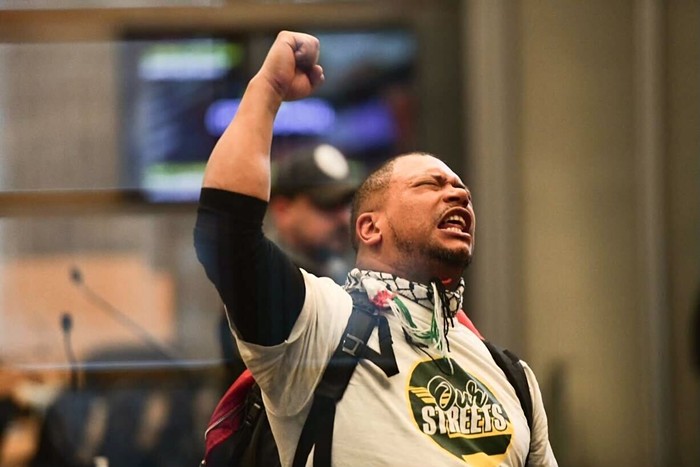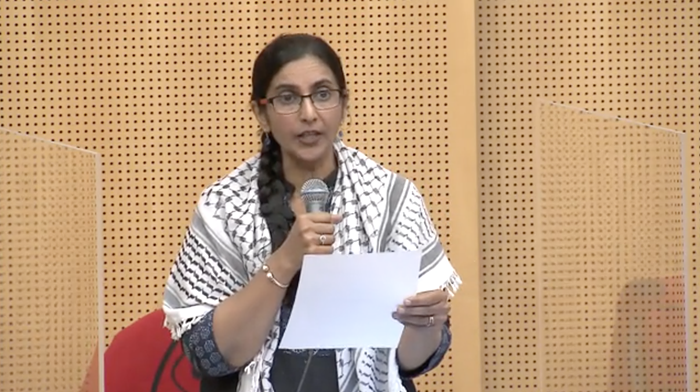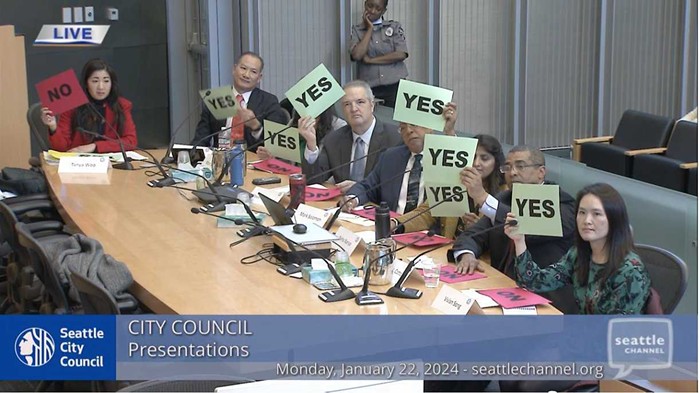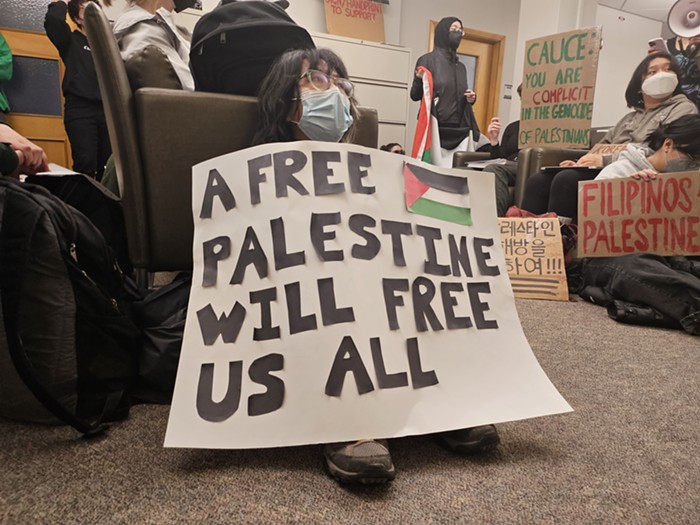
Washington's larger arts, culture, and science institutions have long provided spaces to laugh, cry, and occasionally practice hiding boredom.
They've also helped drive the state's economy. In 2019, the U.S. Bureau of Economic Analysis found that "arts and cultural production" accounted for 8.7% of the state's gross product and nearly 186,000 jobs. But in the last several months, these institutions have taken on another important role in society: public health administration.
As companies welcome audiences back to stages after two long and financially devastating years, they're doing so with new, scrupulously crafted COVID protocols designed to prevent and contain the spread of the virus in their massive venues. To avoid costly shutdowns, they're shelling out for hospital-grade filtration systems, daily testing regimes for performers and crew, more staff to check vaccine cards and IDs, and COVID compliance officers to ensure quality control.
But all that health and safety comes at a price these institutions can't afford, and newly released House and Senate budget proposals don't leave much room for hope. The state's failure to cover these eye-popping COVID mitigation bills could drag out the sector's recovery for years and further demoralize (if that's even possible) the artists and workers who've tried to keep these ships afloat throughout the pandemic.
Staggering losses
Washingtonians support thousands of cultural organizations across the state, which complicates any effort to put an exact dollar amount on the sector's total revenue losses over the last two hell-years, but last month ArtsFund released a survey of 121 cultural orgs that gives us a decent idea of the scale.
That report found a 21% drop in total revenue in 2020 and a 60% reduction in earned revenue in 2021. Those 121 orgs lost nearly $96 million in 2020 alone. Another estimate put statewide 2020 losses somewhere between $191 and $258 million, according to Manny Cawaling, the executive director of Inspire WA, a group that lobbies for expanding access to the state's cultural and scientific organizations.
Last year that group secured $25 million in COVID relief grants for relevant nonprofit organizations with budgets under $5 million, but a technical issue with the proviso language prevented the state from distributing that money. To deal with ongoing pandemic-related losses, this year ArtsWA, the state's art commission, asked Governor Jay Inslee to add another $25 million in the supplemental budget proposal to help those smaller orgs recover. When Omicron kicked into high gear in December and COVID mitigation bills started piling up, Inspire WA pushed for an additional $15 million for orgs with budgets over $5 million, who had been iced out of these state funds.
Cawaling advocated for a holistic approach to funding, and hoped the Governor and the Legislature could meet these institutions where they were at. "Larger organizations with larger auditoriums face more state restrictions without state resources to deal with them. Though equally vital but smaller organizations need to implement testing and masking policies, too, those measures more easily fall into the existing public safety net. When you're The 5th Ave Theatre — with 2,000 seats and big casts and crews — you just can't," he said.
But right now, at least, the Legislature is not meeting those orgs where they're at. The Governor's proposed budget set aside $20 million for the smaller arts orgs, and the House and Senate proposals retained that request. But only the House included money to help large orgs deal with the exorbitant costs of COVID mitigation, and even then it only proposed $5 million. Though lawmakers in both chambers will continue to haggle over budget items for the next two weeks, it's not looking great for the big arts houses.
Now, of course, everybody wants millions of dollars to address their earth-shattering crisis. We're down 255,000 houses statewide, the planet is melting, we're still not fully funding education, we should probably build out a robust addiction treatment infrastructure at some point, and we still have to replace all these culverts because the orcas won't eat another kind of fish. Meanwhile, despite all those needs, Republicans are spending the entire session demanding permanent tax cuts for property and business owners.
That said, every proposed budget this year benefited from billions more in projected revenues than lawmakers expected, none of them spend all the one-time federal COVID relief funding, and all of them boast healthy rainy-day fund refills. And for many large arts organizations, it's not just raining — it's hailing in the middle of a fire tornado, and they're still trying to put on a play.
5th Ave had to set up its own freaking COVID testing lab
Over the phone, 5th Ave Theatre managing director Bernie Griffin said an Omicron outbreak during rehearsals for Beauty and the Beast forced the organization to cancel ten shows and to increase its weekly testing regime to daily antigen testing with weekly PCR screenings. To process the tests with the speed they needed, they had to set up a lab in a rehearsal space. They also brought on three COVID-19 safety specialists to oversee the operation.
During the show's run, management nixed concessions but recruited front-of-house staff to check vaccination cards and IDs. Others guided theatergoers through the 5th’s new entry/exit scheme, which uses multiple doors surrounding the building rather than just the big doors beneath the glowing marquee.
All told, Griffin said the theater is spending $50,000 a week on COVID mitigation efforts, and she’s forecasting $900,000 through July. “To reopen and then get punched with $900,000 — we're just not sure how we’re going to cover that," she said.
Though ticket sales for Beauty and the Beast matched expectations — nearly 30,000 people came through the doors, Griffin said — the theatre "won't get near that for the rest," she said. (No offense to Jersey Boys.)
Substantial local and federal funding has kept the lights on, but it hasn't been enough. So far, the 5th has brought in $16 million in public funds over the course of the last two years, but it spent most of that money to keep some staff onboard and to supplement the cost of ramping back up to full-scale performances for a trepidatious public. "It’s like half a season with all the cost but half the revenue we’d normally have,” she said.
Griffin estimated that her theater alone would probably need “$8 more million to get us back to shows that make the whole model work, and revenue that makes the whole model work."

The story sounds about the same over at the Pacific Northwest Ballet, which runs a dance school as well as one of the top professional ballet programs in the country.
Tallying up the cost of protective gear, regular testing (which costs less than it does at the 5th Ave thanks to a lab shared with other Seattle Center tenants), public compliance officers, the amount of time current human resources spends on COVID, plus costs “navigating each new step with our union groups,” PNB executive director Ellen Walker put the cost of the company's mitigation and containment efforts at $20,000 a week, with a projected total this season running between $400,000 and $500,000.
Recent audiences sizes haven’t offset costs, either. COVID seating protocols and the Omicron outbreak kept the audience for The Nutcracker — the ballet’s bread and butter — at about 80% of what it normally would have been. The most recent run of Roméo and Juliette — which featured a star ballerina retiring after 25 years while playing her signature role — pulled 70% of the audience the company would normally expect to see. If that keeps up, “it’s going to be devastating for this organization," Walker said.
Walker described the $14.6 million in COVID relief funds the company received over the last two years as “sustaining,” but she said they came in the face of $12.3 million in lost revenues in 2021 alone. She guessed that current state funding requests would help most organizations recover in the next three to five years, but a lack of help could push that timeline back years.
Extending that timeline for large arts orgs — assuming they could survive their climb out of the pit — would mean extending the suffering of everyone in the larger cultural and economic ecosystem, too, Walker noted. Individual dancers often build their own dance companies while working at PNB, others make money teaching, and the surrounding bars and restaurants benefit from big shows. "There's a three-to-one multiplier at our institutions — for every dollar someone spends on a ticket to Swan Lake, they spend three at a place nearby," she said.

Over at Benaroya Hall, a spokesperson for the Seattle Symphony said testing and masking protocols cost approximately $15,000 per week. The symphony also upgraded the hall’s HVAC and invested in "equipment to facilitate a low-touch experience for concertgoers."
Box office sales in 2021 did not make up for these costs, with COVID reducing ticket sales 32% from between Sept 1 and Jan 9 compared to the same period during the 2019/20 season.
However, the cocktail of local, state, and federal money — which amounted to nearly $14.4 million, not counting the employee retention tax credit — plus “additional support from fundraising successes” helped balance budgets between 2019 and 2021, and CEO and president Krishna Thiagarajan expects ending the current fiscal year with a balanced budget as well.
Nevertheless, Thiagarajan also predicts a long recovery: “We have been fortunate to receive support from those who value the Symphony and the arts, but it will take several years, and further external support, to make up for the losses caused by the pandemic.”
The upcoming end of mask mandates and proof of vaccine requirements likely won't lead to lower costs, at least not for a while. Griffin said she and the other members of the large arts sector will "probably" have their COVID protocols in place through the end of the season. Whether state lawmakers set aside any money to help them absorb the costs of keeping thousands of patrons safe while reigniting the engine of Washington's cultural economy, however, will depend on whether their constituents care.



















